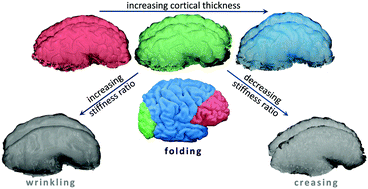Physical aspects of cortical folding
Abstract
The characteristically folded surface of the human brain is critical for brain function and allows for higher cognitive abilities. Recent mostly computational research advances have shown that mechanical instabilities play a crucial role during early brain development and cortical folding. However, it is difficult to investigate such mechanisms in vivo. To experimentally gain deeper insights into the physical mechanisms that underlie the development of brain shape, we use a setup of swelling polymers. We investigate the influence of cortical thickness and the stiffness ratio between cortex and subcortex on the resulting surface pattern by taking the initially smooth fetal brain geometry at week 22 into consideration. The gel specimens possess a two-layered structure accounting for gray and white matter tissue and yield complex surface morphologies that well resemble patterns in the human brain. The results are in good agreement with analytical predictions. Through the variation of cortical thickness and stiffness, it is possible to reproduce cortical malformations such as polymicrogyria and lissencephaly. The results suggest that wrinkling with subsequent transition into folding is the driving instability mechanism during brain development. In addition, the experiments provide valuable insights towards the distinction between wrinkling and creasing instabilities. Taken together, the presented swelling experiments impressively demonstrate the purely physical aspects of brain shape and constitute a valuable tool to advance our understanding of human brain development.



 Please wait while we load your content...
Please wait while we load your content...